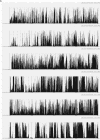Quantitative analysis of rest-activity patterns in elderly postoperative patients with delirium: support for a theory of pathologic wakefulness
- PMID: 18468312
- PMCID: PMC2335393
Quantitative analysis of rest-activity patterns in elderly postoperative patients with delirium: support for a theory of pathologic wakefulness
Abstract
Study objectives: To investigate the feasibility of using wrist actigraphy in a postoperative cohort of elderly patients (delirious versus nondelirious), and to use actigraphy to help characterize diurnal rest-activity patterns in this population.
Methods: This was a prospective postoperative study using wrist actigraphy and clinical scales (DRS-R-98 and Mini-Mental State Examination). Actigraphy was continuous for 24 to 72 hours, and scales were completed once daily. DSM-IV-TR criteria were used to diagnose delirium and to separate the sample into delirium and nondelirium groups. Groups were compared at inception (age, sex, time since surgery, number of medications, number of active medical conditions, and presurgical sleep quality). For actigraphy analysis, a 24-hour sample (taken when the DRS-R-98 score was highest) was used for each patient. Statistical analyses were performed on 6 rest-activity parameters to examine group differences.
Results: Thirteen patients were studied: 6 with delirium and 7 without delirium. The groups did not differ significantly at inception. Significant group differences were found in diurnal rest-activity patterns: delirious patients showed fewer nighttime minutes resting, fewer minutes resting over 24 hours, greater mean activity at night, and a smaller amplitude of change in activity from day to night.
Conclusions: This is the first study to document a significant disruption of the diurnal rest-activity cycle among delirious patients using objective methods and quantitative analysis of activity. Rest and activity consolidation were significantly reduced in delirious patients, as was the amplitude of day-night differences in rest and activity. These findings are consistent with a state of pathologic wakefulness in delirium.
Figures


Similar articles
-
Early Postoperative Actigraphy Poorly Predicts Hypoactive Delirium.J Clin Sleep Med. 2019 Jan 15;15(1):79-87. doi: 10.5664/jcsm.7576. J Clin Sleep Med. 2019. PMID: 30621829 Free PMC article.
-
Actigraphy-based sleep and activity measurements in intensive care unit patients randomized to ramelteon or placebo for delirium prevention.Sci Rep. 2023 Jan 26;13(1):1450. doi: 10.1038/s41598-023-28095-0. Sci Rep. 2023. PMID: 36702822 Free PMC article. Clinical Trial.
-
Screening methods for delirium: early diagnosis by means of objective quantification of motor activity patterns using wrist-actigraphy.Interact Cardiovasc Thorac Surg. 2009 Mar;8(3):344-8; discussion 348. doi: 10.1510/icvts.2008.192278. Epub 2008 Dec 22. Interact Cardiovasc Thorac Surg. 2009. PMID: 19103609
-
Role of Wearable Accelerometer Devices in Delirium Studies: A Systematic Review.Crit Care Explor. 2019 Sep 13;1(9):e0027. doi: 10.1097/CCE.0000000000000027. eCollection 2019 Sep. Crit Care Explor. 2019. PMID: 32166280 Free PMC article. Review.
-
A fresh look at the use of nonparametric analysis in actimetry.Sleep Med Rev. 2015 Apr;20:84-91. doi: 10.1016/j.smrv.2014.06.002. Epub 2014 Jun 20. Sleep Med Rev. 2015. PMID: 25065908 Review.
Cited by
-
An Automated Algorithm for Determining Sleep Using Single-Channel Electroencephalography to Detect Delirium: A Prospective Observational Study in Intensive Care Units.Healthcare (Basel). 2022 Sep 15;10(9):1776. doi: 10.3390/healthcare10091776. Healthcare (Basel). 2022. PMID: 36141389 Free PMC article.
-
Protocol for the Electroencephalography Guidance of Anesthesia to Alleviate Geriatric Syndromes (ENGAGES) study: a pragmatic, randomised clinical trial.BMJ Open. 2016 Jun 15;6(6):e011505. doi: 10.1136/bmjopen-2016-011505. BMJ Open. 2016. PMID: 27311914 Free PMC article. Clinical Trial.
-
Actigraphy for measurement of sleep and sleep-wake rhythms in relation to surgery.J Clin Sleep Med. 2013 Apr 15;9(4):387-94. doi: 10.5664/jcsm.2598. J Clin Sleep Med. 2013. PMID: 23585756 Free PMC article.
-
Early Postoperative Actigraphy Poorly Predicts Hypoactive Delirium.J Clin Sleep Med. 2019 Jan 15;15(1):79-87. doi: 10.5664/jcsm.7576. J Clin Sleep Med. 2019. PMID: 30621829 Free PMC article.
-
Risk factors for delirium in intensive care patients: a prospective cohort study.Crit Care. 2009;13(3):R77. doi: 10.1186/cc7892. Epub 2009 May 20. Crit Care. 2009. PMID: 19457226 Free PMC article.
References
-
- Text Rev. 4th ed. Washington: American Psychiatric Association; 2000. Diagnostic and Statistical Manual of Mental Disorders; pp. 135–147.
-
- Liptzin B, Levkoff SE. An empirical study of delirium subtypes. Br J Psychiatry. 1992;161:843–845. - PubMed
-
- Jacobson S, Jerrier H. EEG in delirium. Sem Clin Neuropsychiatry. 2000;5:86–92. - PubMed
-
- Kojima T, Shimazono Y, Ichise K, Atsumi Y, Ando H, Ando K. Eye movement as an indicator of brain function. Fol Psychiatr Neurol. 1981;35:425–436. - PubMed
-
- Greenberg R, Pearlman C. Delirium tremens and dreaming. Am J Psychiatry. 1967;124:133–142. - PubMed
Publication types
MeSH terms
LinkOut - more resources
Full Text Sources
Medical
